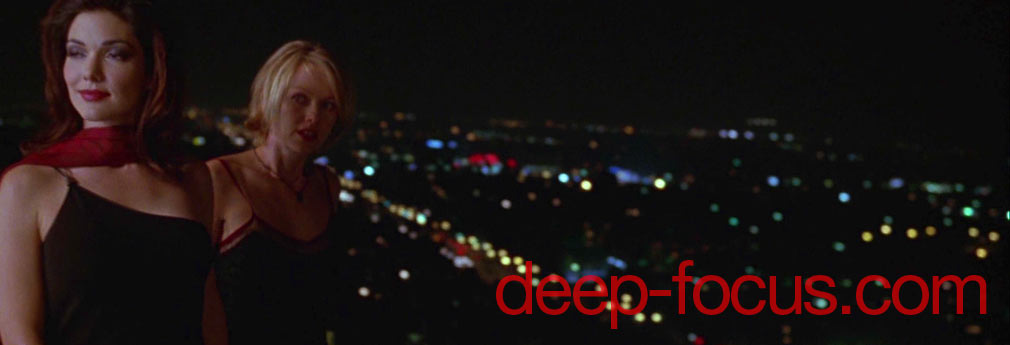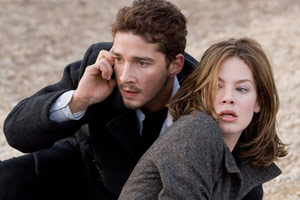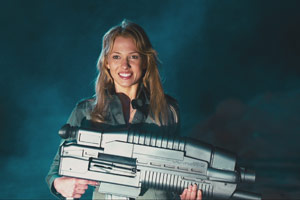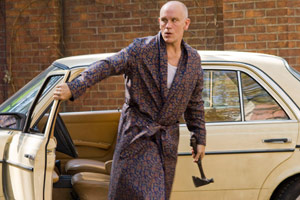Recently in Another Sundance Blog Category
STEPHANIE DALEY
Screened 1/25/06 at Eccles Theatre, Park City, UT
I haven’t seen writer/director Hilary Brougher’s previous Sticky Fingers of Time, but this one is a real movie — conceived, shot and cut with sensitivity and assurance. The subject is Stephanie Daley’s competence to stand trial for her role in the death of her fetus. Amber Tamblyn plays the title character, a 16-year-old who’s dubbed the “Ski Mom” in tabloid-speak after her miscarriage on the side of a snowy mountain in upstate New York. Tilda Swinton plays Lydie Crane, a forensic psychologist working for the prosecution — and expecting her own child — who questions Stephanie about the incident while carrying her own pregnancy-related baggage.
If some of the drama, growing out of flashbacks to Stephanie’s high-school days and uneasy conversations between Lydie and her husband (Timothy Hutton), is a little flat, Brougher makes up for it with key sequences late in the film that touch nerves and bring her real subject into focus. (The inspired, repeated use of a Wrens song called “Everyone Chooses Sides” may indicate Brougher’s dismay at society’s black-and-white approach to such cases.) My line on this one is that it’s the scariest movie about childbearing since the original Alien — a sort of psychological horror film that crosses the everyday terrors of human biology with the chilly question of who bears legal responsibility for tragedy.
WRISTCUTTERS: A LOVE STORY
Screened 1/24/06 at Racquet Club Theatre, Park City, UT
Aspect ratio: 1.85:1
Energized somewhat by Gogol Bordello songs and game actors, Goran Dukic’s debut feature still flags badly in the second half, once the novelty of his conception of an afterlife for suicides where everyone works dead-end jobs and all the music you hear is from singers who killed themselves (and your beater may have a black hole in the floorboards) wears off. Though Patrick Fugit and Shannyn Sossamon make a quirky enough couple, the performances are generally muted and even Tom Waits, in a sizable role, seems to have had personality-reduction surgery in deference to the lethargic, quasi-magic-realist mood. There’s still a welcome sardonic wit in evidence, but the unabashedly happy ending — an apparent alteration from the source novella — feels unearned. A near miss.
QUINCEAÑERA
Screened 1/24/06 at Eccles Theatre, Park City, UT
More soap-opera silly than authentically gritty, Quinceañera springs from the heads of writer/director team Wash Westmoreland and Richard Glatzer as a loving tribute to the Los Angeles neighborhood where they make their home, Echo Park. A quinceañera is basically a girl’s lavish, stops-out 15th-birthday party, and the film is bookended by them. It’s part coming-of-age story, but it’s mostly a self-conscious gentrification drama, showing how the arrival of well-off white folks (including, presumably, the guys who made this movie) starts to move tectonic plates in the old Latino neighborhood. It’s good-hearted and gets a lot of mileage out of solid performances by unknown actors, most notably Jesse Garcia as a wifebeater-bedecked cholo who has an unlikely thing going on with the gay couple that owns his property. It’s also flabby, with a weird subplot indicating a forthcoming virgin birth and cloying reaction shots from resident wise-old-man Chalo Gonzáles meant to guide audience sentiment. This is my first year at Sundance, but I suspect this is an ideal Sundance film. You cut it some slack in the thin mountain air, but it’s unlikely to make much of a connection in the world below.
13 TZAMETI
Screened 1/22/06 at Holiday Village Cinema III, Park City, UT
Aspect ratio: 1.85:1
First-time feature director Géla Babluani’s 13 Tzameti (tzameti is Georgian for thirteen, and like a dope I didn’t take a note on how the title appears on screen, so I’m using the Sundance Film Guide as reference) is one of those high-concept calling-card films that often portend better, more fully developed works to come. Protagonist Sébastien (Georges Babluani) has no idea what he’s in for when he starts following a set of directions meant for a deceased man for whom he has been working as a roofer. There may be money, he figures, at the end of this bleak road.
The story, spare as it is, unfolds slowly over the film’s 93 minute running time, and is nicely enhanced by moody black-and-white cinematography. I have no desire to spoil anything here, but I’ll say that when Sébastien finally reaches his destination, where the population includes Aureil Recoiling and Pascal Bongard, giving intense performances, he finds a dark place dedicated to sating at least a couple of nasty human appetites. Intriguing as it is, I found myself in danger of dozing off before it was over. It’s a one-idea film — albeit a brutishly gripping one — without enough material to sustain itself.
THE PROPOSITION
Screened 1/22/06 at Library Theatre, Park City, UT
Aspect ratio: 2.35:1 (35mm)
If you're familiar with the career of musician Nick Cave (beyond the searching piano ballads, that is), you'll immediately get the aesthetic of the Australian western he's written, The Proposition -- it's a triumph of atmosphere and melodrama, punctuated by ear-piercing blasts of gunfire, splattered in grimy blood, and concerned mainly with moral compromise. The performances are strong, especially Ray Winstone's as Captain Stanley, who offers the captive Charlie Burns (Guy Pearce), member of the infamous Burns family, a deal he can't refuse. (John Hurt, however, almost spoils the mood completely when he appears out of nowhere to chew up the Australian equivalent of sagebrush in a high-decibel cameo early on.) Stanley and Burns are the twin protagonists, with Stanley's titular proposition eventually putting the outlaw Burns, whose family may be as loving in its way as it is brutish, in quite a fix. Someone at my Sundance screening complained about the graphic violence, which comes in sudden, startling bursts (director John Hillcoat got rather defensive, and Cave later mimed kicking the questioner to the curb), and it's true that for a general audience, the film's calculated shock tactics may feel unfair or overwhelming. Also, I wish Cave had resisted the urge to record vocals for the film's soundtrack, which make it feel like a bit of a rock-star vanity project. But as a rich, genre-aware meditation on the evil that men do and the evil to which other men are drawn in an attempt to make things right, The Proposition is a bracing film of great integrity. It would make sense on a double-bill with The Devil's Rejects, but this is the more serious piece of work.
DESTRICTED
Screened 1/20/06 at Library Theatre, Park City, UT
Aspect ratio: 1.85:1 (digital projection)
Destricted is as hit-and-miss as you'd expect of a collection of art-porn shorts directed by visual artists ranging from Gaspar Noé (Irreversible) and Larry Clark (Kids) to Richard Prince and Matthew Barney. The stand-outs for me were Marco Brambilla's "Sync" and Clark's "Impaled."
"Sync" edits together tiny snippets of sex scenes from what I presume must be dozens of different movies in an almost unrecognizable machine-gun style assault on the eyes. (I've got fast eyes and still couldn't identify a single one of the films that were used as source material.) The concept is audacious, but what's really funny about the piece is how it demonstrates the genericism of sex in the movies -- the clips are edited together in clusters that show couples in the same position, shot from the same camera angles, feigning exactly the same kind of middlebrow sexual ecstasy. The montage almost achieves a hilarous sexual energy of its own.
Meanwhile, "Impaled" is one of the best hardcore-porn flicks ever made, even before the fucking starts. Clark invites a bunch of young men to come audition in front of his cameras for the chance to perform in a short sex film. His interviews with them are undeniably salacious, with Clark forcing the audience to join him as voyeur as each up-and-comer is asked to remove his clothes as he speaks. But Clark's also interested in how their perception of the sex act, or at least the terms these guys use to describe it, have been shaped by lives led with easy access to pornography. Their hapless, remarks about shaved pubes or the value of busting a nut all over some chick's face smack of received machismo and got big laughs at the midnight screening, but the film isn't completely crass or condescending (although it is both of those things to some extent), and there's something oddly affecting about all these lost boys. What does it suggest that the kid Clark finally selects as his porn star picks a sex partner who's old enough to be his mother? I also liked Barney's contribution, a Cremaster-esque extravaganza that starts the show with a big black dick growing turgid, very slowly, in close-up, before seguing into a wild encounter between man and heavy machinery, with lots of natural lube involved.
Maybe it's the post-midnight time frame, but my interest flagged during the rest of the segments -- and I certainly didn't catch myself getting aroused. The most dominant recurring motif is guys jacking off, and it got to the point where, whenever some dude started stroking himself, I sighed to myself and sank deeper into my chair, wondering, "OK, how long are we going to have to watch before this guy manages to yank one out?" There's one about a guy jerking off in Death Valley, and one about Balkan folklore, and a couple of different ones about watching porn on TV -- including the capper, Gaspar Noé's "We Fuck Alone," which blends his trademark vertiginous camera work, simulated strobe lighting, and undulating low-frequency sound track (this time with the addition of screaming-baby noises) to no real effect. He admitted before the screening that it was shot a couple weeks ago and completed just a couple of days before the premiere, so I wasn't surprised by the slapdash nature of the finished picture. A cute girl made up to look young gets head from some stuffed animals, a guy with a Peter Murphy haircut jacks off as he pulls a gun on his blow-up doll, cue title card, ho-hum.
At the Q&A;, someone asked why the film featured so much footage of the guy as compared to the girl, and Noé responded that he had better footage of the guy and, besides, he identified with the dude, not the lady. Bummer of a way to head out into the cold Sundance night.
So it's my first year at Sundance, and since the festival wouldn't credential me (they wouldn't even contact to tell me they had rejected my application, although they did send me literature through the mail) I had to attend as a civilian. That means I'm one of those people that I keep hearing the longtime festivalgoers complain about, clogging the streets, sidewalks and stand-by lines and making it more and more difficult to navigate the Sundance experience. It also means every single screening I was really interested in was sold out long before I had a chance to buy tickets, and that press conferences, screenings and parties are off-limits unless I can get someone involved in the film in question to hustle me past security (or unless I happen across a venue’s unlocked back door, which is not unheard of). I’ve only been on the ground here in Utah for a little more than 48 hours, but here’s some stuff that I wish I had known when I was making my (confused) plans for attendance.
Logistics are important. Obviously, the best way to handle a Sundance stay is by doing what you’d do if you were a starving college student in any high-cost rental market – rooming with friends or colleagues to share lodging costs. Since I was doing this on my own, I ended up staying at the Best Western Landmark Inn, which is in Kimball Junction, six miles from Main Street, and runs $179 a night. I have wireless Internet access, a refrigerator and microwave in the room, laundry facilities downstairs, plus a small video arcade (with pinball!). The big downside is convenience. The city shuttle runs right by the hotel every half hour, but takes a good 30 minutes or more. The hotel runs a free shuttle into Park City 12 times a day, which is faster. But the last bus heads back to the hotel at 11:30 p.m., so after that you’re on your own, and cab rides are $15 to $16, which will add up for a dedicated midnight moviegoer. Would I happily stay here again? Sure. But first I’d investigate my options for cheap rooms that are on the circuit for the festival shuttle buses, which get people around the various festival venues quite efficiently.
Don’t get discouraged. Standing in line for the shuttle bus outside the Park City Marriott around 4:30 p.m., I mentioned I was heading, on a whim, for the Eccles Theater, where the opening-night gala film, Friends With Money, was screening at 6:30. Asked if I had tickets, I replied that, no, I was going to check out the stand-by line. At which point someone (not a Sundance rep) told me that the screening was an invitation-only event, that there would be no stand-by line, and that I was wasting my time by visiting the Eccles at all. Someone else agreed. I sort of smiled and said something about how I didn’t have anything better to do anyway and would just go grab some dinner if it didn’t work out. Anyway, when I got to the Eccles there most certainly was a stand-by line. Judging from my eavesdropping skills, it was populated in large part by celebrity spotters who were very into the idea of seeing Robert Redford in the flesh. I didn’t get into the screening, but it was close — and I’m convinced that if I hadn’t wasted my time double-checking my (lack of) credentials at Sundance Headquarters and had instead gotten to the line 20 minutes earlier, I would have gotten in.
The stand-by line is your single most important strategy. The guy at the festival box-office whom I grilled about same-day ticket sales (“very few,” he said) strongly suggested that wait lists were the better option. So I was determined to try the stand-by line again with something I actually wanted to get into: a sold-out Friday screening of Sólo Dios Sabe, which a friend worked on. Unfortunately, I couldn’t get on line until 1:30 p.m., which was just too damned late for a 3 p.m. premiere that was rapidly turning into a circus. I heard they were looking to let at least 35 wait-listers in, and maybe they did, but my ticket (#88) wasn’t even in that ballpark.
That night, I was determined to see Destricted, a sex-themed anthology film with contributions from Gaspar Noé, Larry Clark, Matthew Barney, Richard Prince and others, so I spent some time with friends and headed off alone to the Library Theater around 9 p.m. for an 11:30 screening. Bingo. I was number 12, which was perfect. (If I had come any later, I would have been less confident about getting in. If I had come much earlier, I might have felt self-conscious about heading up a line that pretty much branded me Sundance Pervert #1.) So if I blew close to six hours on a Saturday night seeing just one two-hour film, it was still pretty exciting since the curiosity level was really high and nobody in attendance knew what to expect. Also, I wound up sitting directly behind Noé and Clark before the screening began, which was a moment out of time for sure. Taxis were not in abundance at the venue, so I shuttled back to Main Street to catch a ride back to my hotel (in the Music Taxi, a minivan festooned with Christmas lights that traveled to the beat of “Whipping Post”).
Be the early bird. Saturday morning, I hit the Egyptian at 8:20 a.m. to wait-list the 9 a.m. screening of Sólo Dios Sabe and got in with no problem. I think everybody from the wait list got in. Park City is not a morning town, so if you’re willing to drag ass out the door early enough, you can minimize time spent standing around and maximize time spent with your ass planted in a theater seat.
Fuck Starbucks. The Alpine Internet Cybercafe, located around the 800 block of Main Street, isn’t in the best location, but the coffee is excellent and I don’t think they’re owned by a big megacorporation. (OK, I just googled them and they do have a second location in Breckenridge, Colorado. Did I mention that the coffee is excellent?) The place with the cow outside is more convenient but less delicious. Mmm, coffee.



